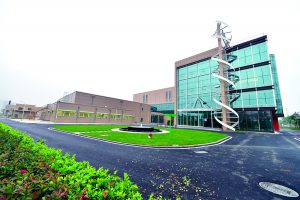Women In Bio Launches Executive-Level Certification Program
To prepare women in life sciences for roles on boards of directors, the national Women in Bio (WIB) organization has launched a program for executive-level board certification. “Women are significantly underrepresented on the boards of life science companies,” says Kristi Sarno, national president of the group, “and the Boardroom Ready program will ensure that more women are qualified, willing, and proactively seeking board memberships. This new initiative is an important step toward promoting women leadership in our industry, and we are pleased to be an integral part of positioning them to assume key roles.”
An organization of professionals committed to promoting careers, leadership, and entrepreneurship of women in the life sciences, WIB announced this new program in May. It will provide them with a full understanding of the duties, responsibilities, and commitments of serving on both public and private company boards. Graduates will have access to events and a network designed to facilitate board appointments. WIB has encouraged its members to participate in the first program this fall (which is no longer accepting applications). LifeSci Advisors, an investor relations and corporate communications firm, is the founding sponsor of the Boardroom Ready program, with additional support provided by MassBio and Biogen.
Michael Rice (president and cofounder of LifeSci Advisors) says, “This program is right at the core of our mission to increase gender diversity in the life-science field — and specifically to increase the number of women on our clients’ boards of directors.”
Inspired by Biogen’s Raising the Bar initiative, this five-day program will be available industry-wide. The fall course will be held at George Washington University in Washington, DC. The curriculum will cover financial literacy and strategy, corporate governance, investor relations, and crisis management. Applicants must have previous managerial experience in the biotechnology industry and currently hold executive positions. Throughout the program and following its completion, WIB and its sponsors will host events around the country to help match program graduates with companies seeking new board members.
“It is clear that the life sciences industry will need a robust and diverse leadership pipeline to sustain its growth and success well into the future,” said Robert Coughlin (president and chief executive officer of MassBio), a life-science trade association representing biotechnology companies, universities, academic institutions, and other research organizations in Massachusetts. MassBio is launching a gender diversity initiative of its own in 2016. “We are thrilled to partner with others to help prepare more women to serve on corporate boards.”
“With only 10% of women in board roles, biotechnology’s gender gap is one of the widest of any industry,” said Adriana Karaboutis (executive vice president of technology and business solutions and corporate affairs at Biogen). “We are excited to see this program move forward through this new partnership as we work to fuel an industry-wide movement to close the gap on corporate boards.”
For more information about the program and instructions for applying for future sessions, please visit www.womeninbio.org/executives/board-ready.
EMA Reports on Drug Safety, New Medicines, and Data
The European Medicines Agency’s (EMA’s) 2015 annual report published in May focuses on the agency’s core tasks: evaluating medicines, supporting research and development of new and innovative treatments, and monitoring benefits and risks of medicines to real patients. In 2015, the EMA recommended marketing authorization for 93 medicines for human use and 14 medicines for veterinary use, including 39 new active substances for humans and seven for veterinary patients. About half of applicants receiving positive opinions for their medicines had asked the EMA for scientific advice during product/process development, a figure that rises to 85% for new active substances. Scientific advice is the EMA’s key tool to promote collection of high-quality data on the benefits and risks of medicines.
Last year EudraVigilance — the EU adverse drug-reaction collection and management system — recorded more than 1.2 million reports of suspected side effects from human medicines. Over 48,000 reports originated from patients in the European Economic Area (EEA), a 30% increase from 2014. The agency considers this to be a positive trend, showing that patients are increasingly reporting the side effects they experience. As new safety data became available, the product information for some medicines could be updated. Those revisions will allow patients, healthcare professionals, and veterinarians to make informed decisions based on the latest evidence when using or prescribing medicines.
The annual report also highlights major projects, initiatives, and achievements in 2015. These include preparations for launching the PRIME (PRIority MEdicines) program to support developing medicines for unmet medical needs; initiatives to help fight antimicrobial resistance and public health threats such as Ebola; and implementation of new legislation to further strengthen the safety monitoring of medicines.
The report includes interviews on three current topics in medicines and health: how data requirements from regulators and health technology assessment (HTA) bodies can be better aligned; whether the use of big data in healthcare is a challenge or an opportunity; and how immunotherapies bring new hope to cancer patients. You can read this annual report online at www.ema.europa.eu/docs/en_GB/document_library/Annual_report/2016/05/WC500206482.pdf.
United States Is the Primary Influence on Global Biopharmaceutical Innovation
The United States ranks first in domestic policies that support worldwide life-science innovation, according to an analysis released by the Information Technology and Innovation Foundation (ITIF), a global technology policy think tank. Released on World Health Day (April 7), the findings come in a new report assessing 56 countries — together representing nearly 90% of the world’s economy — on the extent to which their scientific research, drug pricing, and intellectual property policies encourage global biopharmaceutical innovation.
“World Health Day is a time to reflect not just on what nations can do to generate better health outcomes for their own citizens now, but also for citizens around the world tomorrow,” said coauthor Stephen Ezell, ITIF vice president for global innovation policy. “Life-science innovation requires years of painstaking and expensive research. To ensure that global health outcomes continue improving, more nations must do their share to support biopharmaceutical innovation and not free-ride off the hard work and investment of the leaders.”
Building on previous ITIF research on the impact of national policies and global innovation, this report looks specifically at biopharmaceutical innovation. Ezell and coauthor J. John Wu examined three policy areas that support life-science innovation not only domestically but also have positive spillover effects globally: governmental research and development (R&D) expenditures on health, the extent of price controls on biopharmaceutical drugs, and intellectual property (IP) protections for life-science innovations.
ITIF’s analysis found that the top 10 countries (United States, Switzerland, Taiwan, Singapore, Sweden, Portugal, Austria, Poland, Slovenia, and Estonia) have enacted policies that contribute the most to global life-science innovation (based on GDP). The 10 countries whose policies contribute the least are Costa Rica, Turkey, China, Brazil, Russia, Australia, the Philippines, Thailand, South Africa, and India. Other well-known major players such as Canada (27), Japan (28), and the United Kingdom (24) fall in the middle of the rankings.
“Despite tremendous progress over the past half century, the world is still not producing as much life-science innovation as is needed or possible,” said Ezell. “Countries that fail to invest adequately in life-science research, pay less than their fair share for drugs, or put in place weak IP protections for drugs hurt the entire global community by slowing down biopharmaceutical innovation.”
Robert D. Atkinson (ITIF’s president) said, “All nations need to do their part to support robust global biopharma innovation.” Read the full report online at http://www2.itif.org/2016-national-policies-global-biopharma.pdf.
Hematological Cancers Market Growing Despite Patent Expirations
Business intelligence provider GBI Research predicts that the market for hematological cancers (e.g., leukemia, lymphoma, and myeloma) will more than double over seven years from $30.7 billion in 2015 to $70.1 billion by 2022. That represents a compound annual growth rate of 12.5%. GBI’s recently published report, Global Hematological Cancers Market to 2022: Commercially Successful Targeted Therapies and Large, Innovative Pipeline to Drive Market, states that strong growth will come as new drugs hit the market and the prevalence of hematological cancers increases. This growth is expected in spite of key patent expirations for biologics such as Rituxan (rituximab) and chemotherapies such as Gleevec (imatinib) and Velcade (bortezomib).
GBI senior analyst Yasser Mushtaq says, “The significant revenue lost by targeted drugs will be counteracted by recently approved drugs and pipeline products. Keytruda (pembrolizumab), for example, is already marketed for metastatic melanoma and in phase 3 testing for multiple myeloma and refractory multiple myeloma. It is also in phase 2 development for a number of lymphomas and will therefore contribute to market revenue over coming years.”
Mushtaq thinks that a number of drugs will develop into blockbusters. For example, small-molecule Venetoclax (venetoclax) should hit sales of US$3.5 billion in 2022, up from an estimated $155.2 million in 2016. It is in development with AbbVie and Roche and represents a trend in the market toward expensive targeted therapies. As their use continues to generate revenue above that of nonspecific chemotherapy treatments, companies investing in the hematological cancers pipeline (and targeted therapies) will substantially drive the market.
Mushtaq continues, “The major market players — including Celgene, Roche, AbbVie, Novartis, and Johnson & Johnson — are expected to maintain their strong positions. AbbVie will display the strongest growth, driven by its acquisition of Pharmacyclics, which was already a strong performer in this disease cluster.”
Using annualized market data from 2015 and forecast to 2022, this report presents analysis of the market space across seven major countries: the United States, France, Germany, Italy, Spain, the United Kingdom, and Japan.
JHL Biotech Opens Innovative Biosimilars Manufacturing Facility in China
 In May 2016, JHL Biotech opened the world’s first GE Healthcare KUBio biopharmaceutical manufacturing facility with single-use bioprocessing technology in Wuhan, China. A biopharmaceutical company focused on providing the world with high-quality, low-cost medicines, JHL will manufacture biosimilars and monoclonal antibodies (MAbs) for late-stage clinical trials and commercial marketing at this site. The KUBio concept is a prefabricated facility designed to comply with good manufacturing practices (GMPs) for scalable and cost-efficient manufacturing. This facility also will provide process development and manufacturing services for JHL’s global contract manufacturing customers. JHL and GE Healthcare partnered to complete facility construction in just 18 months.
In May 2016, JHL Biotech opened the world’s first GE Healthcare KUBio biopharmaceutical manufacturing facility with single-use bioprocessing technology in Wuhan, China. A biopharmaceutical company focused on providing the world with high-quality, low-cost medicines, JHL will manufacture biosimilars and monoclonal antibodies (MAbs) for late-stage clinical trials and commercial marketing at this site. The KUBio concept is a prefabricated facility designed to comply with good manufacturing practices (GMPs) for scalable and cost-efficient manufacturing. This facility also will provide process development and manufacturing services for JHL’s global contract manufacturing customers. JHL and GE Healthcare partnered to complete facility construction in just 18 months.
Manufacturing locally in China is considered to be a more affordable way to provide modern therapies for deadly diseases such as cancer, which is the leading cause of death in that country. In 2015, some 4.3 million new cancer cases were reported in China.
Racho Jordanov (JHL’s chief executive officer and cofounder) commented, “JHL Biotech’s mission is to make quality medicines affordable to more people, and we believe one of the greatest areas of need is in Asia. It was important for us to establish our scale-up manufacturing capacity in Asia with a manufacturing facility in China capable of producing biologics to a world-class standard. JHL Biotech now has the largest volume of single-use cell culture capacity in Asia with the opening of our new facility in Wuhan.”
China’s State Council’s 10-year action plan “Made in China 2025” recognizes biological medicines and medical devices as one of its key industrial focus areas. The biosimilars market is expected to grow significantly in China and reach $350 million in 2019.
John Flannery (GE Healthcare’s president and chief executive officer) commented, “We have been working closely with our customers and observing market needs carefully. As a result, we have created an innovative solution improving access to biopharmaceuticals all over the world. We are providing a complete manufacturing solution faster than anyone else, which means that JHL is able to enter the market with high-quality pharmaceuticals responding to a real market needs in record time.”
57 Muslim Nations Establish a Multinational Biotech Company
The Organization of Islamic Cooperation (OIC), the world’s second largest intergovernmental organization is establishing a multinational company with shared ownership across its member states for vaccines, pharmaceuticals, and agrobusiness manufacturing. The announcement was made in May at the Fifth Islamic Trade Fair in Riyadh, Saudi Arabia. The project will promote intra-OIC investment; generate employment among economically marginalized demographics including youth; and increase prosperity and welfare through international competitiveness of OIC exports.
The 9th Forum for Businesswomen in Islamic Countries also was held during the Trade Fair. This forum convened about 400 businesswomen from Islamic countries to help identify their needs and explore ways of overcoming the challenges they face.
OIC secretary general Iyad Madani said, “It is crucial during the next decade that the Islamic world, which stands at a crucial juncture in its history, begins moving towards an OIC common market so that intra-OIC trade becomes a tool for peace, prosperity, and stability across the Islamic world.”


